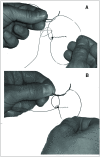The ultimate Aberdeen knot
- PMID: 17959013
- PMCID: PMC2121271
- DOI: 10.1308/003588407X205468
The ultimate Aberdeen knot
Abstract
Introduction: The Aberdeen knot has been shown to be stronger and more secure than a surgeon's knot for ending a suture line. No data exist as to the ideal configuration of the Aberdeen knot. The Royal College of Surgeons of England in their Basic Surgical Skills Course, 2002 recommended six throws. The aim of this experiment is to find the ideal combination of throws and turns.
Materials and methods: Aberdeen knots of various configurations were tied in 0-PDS suture (Ethicon, Johnson and Johnson). Each configuration was tied 10 times. A materials testing machine was used to test the knots to destruction in a standardised manner.
Results: The knots were seen to behave in two ways. They either slipped and unravelled, or broke. Knots tied with fewer than three throws were unreliable. Knots tied with three throws and two turns appear to be the strongest configuration. Adding further throws and turns does not increase the strength of an Aberdeen knot.
Conclusions: An Aberdeen knot tied with three throws and two turns is the ultimate Aberdeen knot.
Figures













Similar articles
-
Knot Security 101: A Comprehensive Practical Review to Optimal Knot Configuration, Pulling Direction, Throw Count, and Tail Length.Plast Reconstr Surg Glob Open. 2024 Aug 9;12(8):e6047. doi: 10.1097/GOX.0000000000006047. eCollection 2024 Aug. Plast Reconstr Surg Glob Open. 2024. PMID: 39139841 Free PMC article. Review.
-
In Vitro Evaluation of the Aberdeen Knot for Continuous Suture Patterns with Large Gauge Suture.Vet Surg. 2016 Oct;45(7):955-961. doi: 10.1111/vsu.12538. Epub 2016 Sep 8. Vet Surg. 2016. PMID: 27604910
-
Effect of fluid media on the mechanical properties of continuous pattern-ending surgeon's, square, and Aberdeen knots in vitro.Vet Surg. 2017 Feb;46(2):306-315. doi: 10.1111/vsu.12627. Vet Surg. 2017. PMID: 28146293
-
Tensile strength of a surgeon's or a square knot.J Surg Educ. 2010 Jul-Aug;67(4):222-6. doi: 10.1016/j.jsurg.2010.06.007. J Surg Educ. 2010. PMID: 20816357 Free PMC article.
-
In vitro evaluation of square and surgeon's knots in large gauge suture.Vet Surg. 2017 Feb;46(2):297-305. doi: 10.1111/vsu.12619. Vet Surg. 2017. PMID: 28146289
Cited by
-
Knot Security 101: A Comprehensive Practical Review to Optimal Knot Configuration, Pulling Direction, Throw Count, and Tail Length.Plast Reconstr Surg Glob Open. 2024 Aug 9;12(8):e6047. doi: 10.1097/GOX.0000000000006047. eCollection 2024 Aug. Plast Reconstr Surg Glob Open. 2024. PMID: 39139841 Free PMC article. Review.
-
Laparoscopic gastric sleeve, subtotal antrectomy and omentoplasty.Obes Surg. 2015 Jan;25(1):195-6. doi: 10.1007/s11695-014-1450-4. Obes Surg. 2015. PMID: 25351612
-
Sliding self-locking first stitch and Aberdeen knot in suture reinforcement with omentoplasty of the laparoscopic gastric sleeve staple line.Obes Surg. 2014 Oct;24(10):1739-40. doi: 10.1007/s11695-014-1352-5. Obes Surg. 2014. PMID: 25085221 No abstract available.
-
Learning curve of minimally invasive two-port laparoscopic myomectomy.JSLS. 2012 Jan-Mar;16(1):112-8. doi: 10.4293/108680812X13291597716267. JSLS. 2012. PMID: 22906339 Free PMC article.
-
Lariat knot: simple tying technique for robotic and endoscopic sutures.J Robot Surg. 2025 May 31;19(1):251. doi: 10.1007/s11701-025-02419-w. J Robot Surg. 2025. PMID: 40448744
References
-
- Shaw A, Duthie GS. A simple assessment of surgical sutures and knots. J R Coll Surg Edinb. 1995;40:388–91. - PubMed
-
- Bigon MRG. The Century Guide To Knots. 2nd edn. Verona: Officine Grafiche di Arnoldo Mondadori; 1983.
-
- Ashley CW. The Ashley Book of Knots. 13th edn. London: Faber and Faber; 1944.
-
- Paterson-Brown S, Dudley HA. Knotting in continuous mass closure of the abdomen. Br J Surg. 1986;73:679–80. - PubMed
-
- Raven Department of Education. Basic Surgical Skills Course. London: The Royal College of Surgeons of England; 2002.
Publication types
MeSH terms
LinkOut - more resources
Full Text Sources
Miscellaneous

